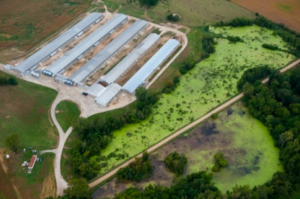
Download this in PDF form, here.
What is an algal bloom?
An algal bloom is a rapid increase in algae growth that can occur in freshwater and marine environments. Algal blooms can be green (see image above), blue, red, or brown and sometimes they are so bright that it looks like a layer of paint is covering the surface of the water. Many algal blooms release toxins, but some are non-toxic.
What causes an algal bloom?
Nutrients in animal manure like nitrogen and phosphorus stimulate algae growth, so if CAFO waste is overapplied to fields, leaks from lagoons, or otherwise enters waterways, it can produce massive algal blooms. Sunlight and slow-moving water also contribute to rapid algae growth. You are more likely to find algal blooms in still water than rivers or fast-moving streams.
Why should you be worried?
Human health. Algae is not always harmful, but algal blooms often release toxins that are dangerous to humans and other animals. Drinking water affected by an algal bloom can cause illness in the stomach and liver, respiratory system issues, and even have neurological effects. Swimming in water affected by an algal bloom is also hazardous because water may accidentally be swallowed and external contact can produce a rash. Algal blooms may be caused by excessive nitrates in the water; nitrate contamination has its own set of human health risks, especially for infants. Furthermore, algal blooms dramatically increase the cost of water treatment for local municipality water treatment facilities (while polluting facilities are not accountable for remediation costs) and disinfectants used to treat water may have harmful side effects, as well. Learn more about how nutrient pollution and algal blooms impact human health here.
Environmental impacts. Algal blooms often lead to fish kills. If small aquatic organisms consume toxic algae, the toxins can move through the food system to eventually kill larger fish and even aquatic birds. Non-toxic algal blooms may be just as lethal: clogging fish gills, blocking sunlight from going past the water’s surface, and over-consuming oxygen that aquatic animals need to survive. Learn more about how nutrient pollution and algal blooms affect the environment here and here.
What can you do?
- Call the Missouri Department of Natural Resources Environmental Emergency Response (EER) Section at 573-634-2436. Algal blooms can be called in to DNR’s 24-hour spill emergency hotline. You may also report algal blooms to DNR as an environmental concern; see Reporting Concerns for details.
- Call the Missouri Department of Health and Senior Services (DHSS) Public Health Emergency Hotline at 800-392-0272. Note DHSS primarily manages concerns for private water bodies. However, it is still important to report algal blooms as a public health concern.
- Submit a Suspected Harmful Algal Bloom (HAB) notification form to the Department of Natural Resources here. “The [D]epartment urges people to notify staff of blooms” since they are a serious public health, environmental, and economic issue. Fill out the form to the best of your abilities, attach photos, email it to moHABreport@dnr.mo.gov and include your contact information so the Department can follow up with any questions about your report.
- Take pictures. Photos provide clear evidence of the environmental concern as you witnessed it and can help confirm its location. In the case of an algal bloom, a well-taken photo will show the approximate extent of the algal growth, characteristics of the surrounding water like color and/or possible pollutants, and perhaps capture some of the surrounding area to identify the location. Unfortunately, the DNR Environmental Concern Report form does not provide a section to upload images. However, you may email photos to the DNR along with your concern report to provide supporting evidence. Photos are also a way to demonstrate evidence of harm, which helps establish legal standing for an individual or organization to pursue environmental litigation.
- Test the water. You can collect your own water samples and purchase test strips to perform low-cost water analysis for nitrates, phosphorus and a variety of other water quality criteria. You may compare your results against Missouri’s Water Quality Standards, however note that human and environmental health concerns may still exist at levels below the standard. To perform higher-accuracy tests, you may consider sending water samples to a DNR-certified lab for chemical or microbiological analysis. Some labs are only approved to perform certain water tests, so make sure to choose a lab that can test for the criteria you are interested in (nitrate, phosphorus, E. coli) and use the contact information provided to get a time frame and cost estimate for testing.
The Missouri Stream Team Volunteer Water Quality Monitoring Program (VWQPM) is a partnership of the Department of Natural Resources, Department of Conservation, Conservation Federation of Missouri and citizens of Missouri. VWQPM conducts advanced monitoring projects, which have included nitrate measurements for streams, however VWQPM is not set up to receive and test samples from the public.
The Missouri Department of Health & Senior Services (MDHSS) tests public drinking water supplies for E. coli and coliform bacteria every month. You may also submit your own water samples to the Missouri State Public Health Laboratory (MSPHL) at any time. Use this form to request a water sampling kit or call the MSPHL at 573-751-4830 and contact your local public health agency to find the appropriate sample drop-off location. Note that the MSPHL only performs tests for total coliforms and E. coli in drinking water sources; not all water bodies are public drinking water sources and you may want to test your samples for other criteria like nitrates and phosphorus.
